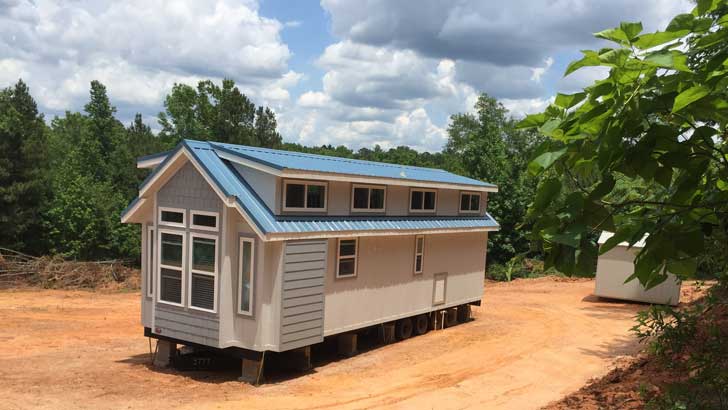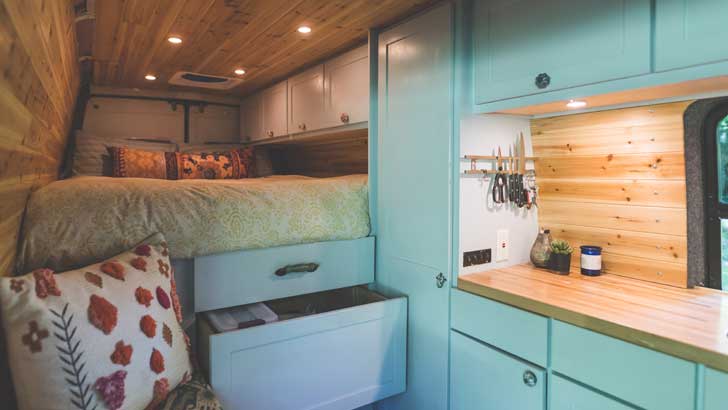Are tiny houses the answer to the housing affordability problem?
By Susan Hely
The tiny house movement is booming, spurred on by lifestyle shows and social media.
Stylish micro homes offer an escapist fantasy of decluttering your life and simplifying what you need, along with shaving housing costs and reducing your carbon footprint.
How to go tiny
With tiny houses the options are endless, they can be:
- Architecturally designed
- Ready built
- DIY from recycled everyday materials such as a shipping containers, old buses or vans
- On wheels such as the back of a truck.
The best part is they can be built quickly and cheaply, with prices ranging from $10,000 to over $120,000 with special features.
Reducing debt, inability to afford a conventional home, sustainable living, or a life crisis are just a few reasons.
Preparing for an uncertain future in the face of climate change by going off-grid is another, according to the Australian Tiny House Association.

Homes for all
Recently tiny houses are being championed as a shelter for disadvantaged people such as homeless or impoverished older women. But it's not necessarily the solution to affordable housing, cautions Dr Laura Crommelin from the UNSW City Futures Research Centre.
"The challenge with housing affordability is not just the cost or size of the house itself," says Crommelin. "The price is mainly in the land."
Crommelin says all tiny houses need to be placed on a piece of land, which needs to be purchased. "You don't solve the land problem by replacing a different type of house with a smaller, tiny house."
Crommelin says apartments are still likely to be a more economical use of space than a tiny house.
"You can fit more apartments on a piece of land than you could tiny houses," she says.
"Apartments aren't right for everyone, but we should try to do a fair assessment of what it means to live in an apartment and the pros and cons of that. I think there are some benefits to apartment living that people don't always appreciate."
Subdivisions and minimum block sizes would also be among the planning issues needing careful consideration.
Crommelin says if we were to see a really big uptake in tiny houses, we would need to think through all the planning implications in a way that hasn't happened at this stage, and how a model would work.
"Fragmented land ownership is something we already grapple with, so it would be risky to subdivide. And much like apartments, if people are going to be living in tiny homes, they're going to need other infrastructure to support them as an add on to their smaller personal space like parks, shops, community spaces, libraries, and public services."
While some tiny houses are mobile, the researcher says they might be considered "more like a caravan, which would have its own set of regulations".

Equity matters
Crommelin also has concerns about the equity issues that come with tiny houses.
"If it's made such that a certain segment of the population ... that's all they can aspire to; you're essentially saying that they don't deserve normal-sized housing like everyone else. That's a real concern because there's no reason why we couldn't have decent-sized housing for everyone."
Crommelin says that changing the current investment model of housing would be a more sensible approach and would directly address the housing affordability issue.
"We have built a housing model around speculative investment, mum and dad investors, and all of that contributes significantly to inflating the housing affordability issue," she says. "We could eliminate the tax breaks that support housing investment so that it might become more affordable to enter the owner-occupier market."
Other changes to our housing system could also help. Crommelin says there is a 'missing middle' for different living arrangements that we haven't invested in and which would allow people to own a house, but also accommodate more density.
"Also, if we saw a big investment in public housing, you could change the nature of the housing affordability issue. It wouldn't happen overnight, but it would make a huge difference - it's just not as fun or 'sexy' as a tiny home," she says.
Crommelin says there will always be reasons why people want to own their home, and while tiny houses might not be the silver bullet, they do provide value in rethinking the way we plan and build our cities.
There are books such as The Not So Big House and a TV series, Tiny House Nation. You can spend $99 to $199 per night to stay in a tiny house at tinyaway.com.
Get stories like this in our newsletters.



